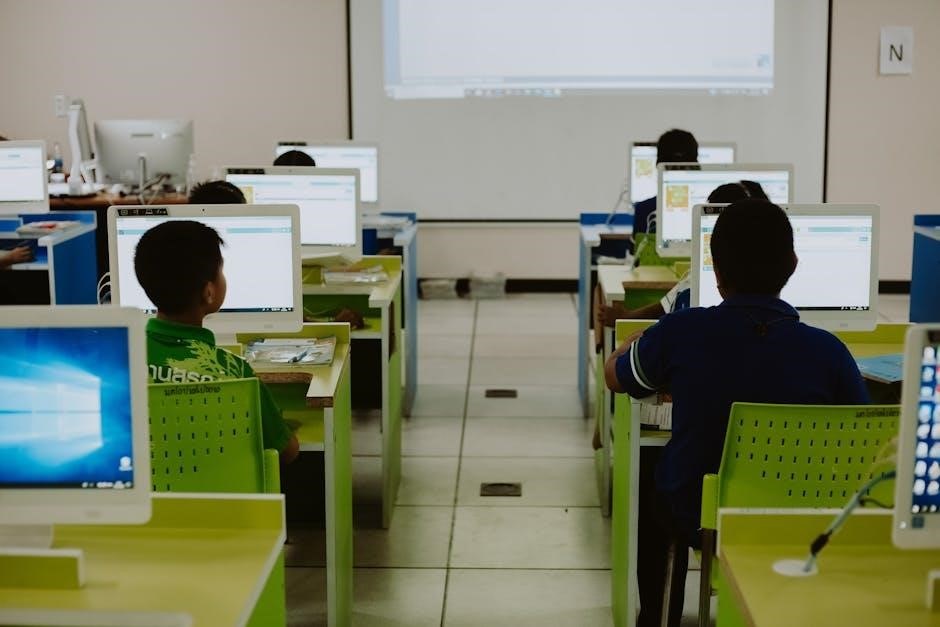Instructional fundamentals form the cornerstone of effective teaching, providing frameworks for curriculum design, learning theories, and teaching strategies. They guide educators in creating structured, engaging learning experiences, ensuring students achieve educational goals through evidence-based practices.
1.1 Definition of Instructional Fundamentals
Instructional fundamentals refer to the core principles and methods that guide the planning, delivery, and assessment of teaching and learning experiences. They encompass essential elements such as curriculum design, learning theories, and teaching strategies, providing a framework for educators to create structured and effective learning environments. These fundamentals ensure that instruction is aligned with educational goals, promotes active engagement, and addresses the diverse needs of learners. By focusing on evidence-based practices, instructional fundamentals help educators organize content, facilitate cognitive processes, and support skill development, ultimately enhancing student outcomes and fostering a deeper understanding of subject matter.
1.2 Importance of Instructional Fundamentals
Instructional fundamentals are crucial for ensuring educational effectiveness and efficiency. They provide educators with a structured approach to teaching, enabling them to align instruction with learning objectives and cater to diverse student needs. These principles ensure that content is delivered in a logical sequence, promoting progressive learning and skill development. Moreover, instructional fundamentals enhance student engagement, motivation, and overall academic performance. They also support the development of critical thinking and problem-solving abilities, preparing learners for future challenges. By adhering to these foundational principles, educators can create meaningful and impactful learning experiences, fostering a strong academic foundation and lifelong learning skills.
1.3 Brief History of Instructional Design
The history of instructional design traces back to the mid-20th century, evolving alongside educational psychology and technology. Early influences include behaviorist and cognitive learning theories, which shaped systematic approaches to teaching. The 1950s saw the rise of audiovisual instruction, while the 1960s introduced programmed instruction. The 1970s and 1980s brought the development of landmark models like ADDIE and Dick and Carey’s Systematic Design of Instruction. These frameworks emphasized structured planning and alignment of objectives with outcomes. The advent of digital technology in the 1990s and 2000s revolutionized instructional design, incorporating multimedia and online learning. Today, it continues to adapt, integrating AI and data-driven practices to enhance learning experiences.

Learning Theories
Learning theories explain how individuals acquire knowledge and skills, shaping instructional strategies. They include behaviorist, cognitive, and constructivist approaches, each offering unique insights into effective teaching methods.
2.1 Behaviorist Theory
The behaviorist theory focuses on observable behaviors and external stimuli, emphasizing reinforcement and conditioning. It suggests learning occurs through interactions with the environment, where rewards encourage desired actions and punishments discourage undesired ones. This theory is often applied in structured, repetitive tasks and clear goal-setting. For example, positive reinforcement, such as praise or badges, motivates learners. Behaviorism is particularly effective in training scenarios where specific behaviors or skills need to be developed consistently. It provides a clear framework for designing instructional content that promotes measurable outcomes and skill acquisition through systematic feedback and practice.
2.2 Cognitive Theory
Cognitive theory emphasizes the mental processes involved in learning, focusing on how individuals perceive, process, and store information. It highlights the role of prior knowledge, memory, and problem-solving in acquiring new skills. Unlike behaviorism, cognitive theory explores the internal mechanisms that drive learning, such as attention, encoding, and retrieval. It suggests that learners actively construct meaning by organizing and connecting new information to existing knowledge. Strategies like scaffolding, metacognition, and spaced repetition align with this theory, helping learners manage cognitive load and enhance retention. By understanding how the mind processes information, educators can design instruction that supports deeper understanding and critical thinking.
2.3 Constructivist Theory
Constructivist theory posits that learners construct knowledge through active engagement and social interaction, rather than passively receiving information. This approach emphasizes personal experience, context, and collaboration, viewing learning as a process of building understanding unique to each individual. Constructivists argue that meaning is not fixed but emerges from the learner’s interpretation of experiences. Educators using this theory encourage inquiry-based learning, problem-solving, and reflective practices. It also highlights the importance of cultural and social influences on learning, advocating for inclusive and diverse educational environments. By fostering critical thinking and personal relevance, constructivist methods aim to create deeper, more meaningful learning experiences tailored to individual needs and backgrounds.

Instructional Design Models
Instructional design models provide structured frameworks for creating effective learning experiences, guiding educators through stages from analysis to implementation, ensuring aligned objectives and outcomes.
3.1 ADDIE Model
The ADDIE Model is a popular instructional design framework consisting of five phases: Analysis, Design, Development, Implementation, and Evaluation. It systematically guides the creation of educational materials, ensuring alignment with learning objectives. Each phase builds on the previous one, allowing for continuous improvement and adaptation. Analysis identifies learning needs and goals, while Design outlines the structure and strategies. Development involves creating content, and Implementation delivers it to learners. Finally, Evaluation assesses effectiveness and informs future enhancements. This model emphasizes a structured approach to instructional design, making it a cornerstone in education and training environments.
3.2 Dick and Carey’s Systematic Design of Instruction Model
Dick and Carey’s Systematic Design of Instruction Model is a structured framework for creating effective instructional programs. It emphasizes clear learning objectives, systematic planning, and continuous evaluation. The model focuses on performance-based outcomes, ensuring learners achieve specific skills or knowledge. Key phases include identifying learning needs, defining objectives, designing assessments, developing materials, and evaluating outcomes. This approach prioritizes alignment between instruction and desired results, making it highly practical for educators and instructional designers. By integrating learner characteristics and contextual factors, the model ensures tailored and impactful learning experiences, aligning with modern educational standards and evidence-based practices.
Teaching Methods and Strategies
Teaching methods and strategies are essential for effective instruction, incorporating experiential learning, problem-based approaches, and interactive resources to engage learners and enhance knowledge retention.
4.1 Experiential Learning
Experiential learning engages learners through hands-on activities, fostering deeper understanding and practical skills. It encourages active participation, reflection, and real-world application, enhancing retention and critical thinking abilities effectively.
4.2 Problem-Based Learning
Problem-Based Learning (PBL) is an instructional approach where learners engage with real-world problems to develop critical thinking and problem-solving skills. It emphasizes collaborative learning, as students work in groups to identify solutions, fostering creativity and teamwork. PBL encourages active learning by requiring students to apply theoretical knowledge to practical scenarios, enhancing their ability to analyze complex situations. This method also promotes deeper understanding and retention of material, as learners are motivated by the relevance of the tasks to real-life challenges. Educators act as facilitators, guiding students through the process without providing direct solutions, thereby nurturing independence and self-directed learning. This approach is widely used in various educational settings to prepare students for future professional environments. PBL not only enhances academic performance but also builds essential life skills, making it a valuable instructional strategy in modern education.

Assessment and Evaluation
Assessment and evaluation are crucial for measuring student learning outcomes. They ensure alignment with instructional goals, provide feedback, and improve educational quality through continuous improvement strategies.
5.1 Formative Assessment
Formative assessment is an ongoing, flexible process used to monitor student learning during instruction. It provides immediate feedback to both educators and learners, helping to identify strengths, weaknesses, and knowledge gaps. Through methods like quizzes, class discussions, and assignments, formative assessment allows teachers to adjust their instructional strategies in real-time. This approach fosters a more personalized learning experience, enabling students to track their progress and stay motivated. Additionally, it helps educators refine their teaching techniques, ensuring that learning objectives are met effectively. The use of technology, such as learning management systems (LMS), further enhances formative assessment by offering interactive tools and data-driven insights to support student development.
5.2 Summative Assessment
Summative assessment evaluates student learning at the end of an instructional period, such as a unit, course, or program. Its primary purpose is to measure whether learning objectives have been met and to provide a final judgment of student performance. Common methods include tests, exams, projects, and final presentations. Unlike formative assessment, summative assessment is not used to guide instruction but rather to determine the extent of learning achievement. It often contributes to grading and accountability, offering insights into the effectiveness of instructional strategies. Additionally, summative assessment helps identify areas for curriculum improvement and ensures educational standards are upheld. Technology tools, like learning management systems, can streamline this process through automated grading and detailed performance reports.

Technology Integration in Instruction
Technology integration enhances instruction by providing tools like LMS, multimedia, and AI, fostering engagement and efficient learning. It streamlines processes, supports diverse learning needs, and promotes innovation.
6.1 Learning Management Systems (LMS)
A Learning Management System (LMS) is a digital platform designed to organize, deliver, and track educational content. It streamlines instruction by providing centralized access to materials, assignments, and resources. Educators can use LMS tools to monitor student progress, facilitate communication, and assess performance efficiently. Key features include course enrollment, grade tracking, and interactive elements like forums and quizzes. LMS platforms reduce the need for physical materials, enabling hybrid and online learning models. They also support personalized learning experiences by allowing educators to tailor content to individual needs. By integrating LMS, instructors can enhance engagement and create a more dynamic learning environment.
Modern LMS solutions often incorporate multimedia and collaboration tools, making them versatile for diverse instructional strategies. They enable seamless interaction between students and educators, fostering a connected learning community. Additionally, LMS platforms provide data analytics, helping educators identify areas for improvement and measure learning outcomes effectively. As technology advances, LMS continues to play a pivotal role in transforming education, offering innovative ways to manage and deliver instruction.
6.2 Multimedia and Visual Aids in Instruction
Multimedia and visual aids are essential tools in modern instruction, enhancing engagement and understanding. They include images, videos, audio, and interactive elements that cater to diverse learning styles. Visual aids like charts, diagrams, and infographics simplify complex information, making it easier for learners to grasp key concepts. Multimedia elements, such as videos and simulations, provide dynamic representations of ideas, fostering deeper comprehension. These tools also capture students’ attention, boosting participation and retention. By integrating multimedia, educators can create immersive learning experiences that address visual, auditory, and kinesthetic preferences, ensuring a more inclusive and effective instructional approach.

Curriculum Development
Curriculum development involves designing educational programs to meet learning objectives, incorporating needs assessments, and aligning content with educational goals to ensure relevance and effectiveness for diverse learners.
7.1 Needs Assessment
Needs assessment is a critical step in curriculum development, identifying gaps between current and desired learning outcomes. It involves gathering data on learners’ skills, knowledge, and performance to determine educational priorities. This process ensures that the curriculum addresses real needs, making it relevant and effective. By analyzing learner profiles, educational goals, and environmental factors, educators can design targeted programs that bridge gaps and enhance learning experiences. A well-conducted needs assessment lays the foundation for a curriculum that is both responsive and impactful, ensuring resources are allocated efficiently to meet learner demands and institutional objectives.
7.2 Curriculum Design
Curriculum design is the process of creating structured educational programs that align with learning objectives and institutional goals. It involves organizing content, activities, and assessments to ensure a logical flow of learning experiences. Effective curriculum design considers the needs of learners, the subject matter, and the educational context. It reflects the collective thinking expressed in education literature, summarizing what students should know and be able to do. A well-designed curriculum balances theoretical knowledge with practical skills, ensuring learners are prepared for real-world applications. By integrating instructional strategies and evaluation methods, curriculum design enhances the overall quality of education, making it engaging and meaningful for students. This process is vital for achieving educational excellence and meeting institutional objectives.

Instructional Materials
Instructional materials include textbooks, workbooks, and digital resources that support learning objectives. They provide structured content, activities, and visual aids to enhance understanding and engagement for diverse learners.
8.1 Textbooks and Workbooks
Textbooks and workbooks are essential instructional tools, providing structured content aligned with learning objectives. Textbooks offer comprehensive overviews of subjects, while workbooks include exercises for practical application, reinforcing concepts through hands-on activities. These materials cater to diverse learning styles, ensuring accessibility and engagement. They often incorporate visual elements like graphs, charts, and diagrams to aid comprehension. Workbooks encourage active participation, helping students apply theoretical knowledge. Together, they form a foundational resource for educators, facilitating systematic and organized learning experiences that support student progress and understanding of key concepts in various subjects.
8.2 Digital Resources
Digital resources are versatile tools that enhance learning experiences by providing interactive and accessible content. They include online platforms, multimedia materials, and educational software that cater to diverse learning styles. These resources often incorporate search-and-find features, making information retrieval efficient. Tools like Learning Management Systems (LMS) and AI-driven companions, such as Google’s Learn About, offer structured learning paths and generative capabilities. Digital resources support interactive activities, real-time feedback, and personalized learning, making them invaluable in modern education. They also facilitate engagement through visual aids like graphs, diagrams, and videos, ensuring complex concepts are comprehensible. By integrating technology, digital resources create dynamic, adaptable learning environments that meet the needs of today’s learners.

Classroom Management
Classroom management involves creating a structured, respectful environment that fosters learning and minimizes disruptions. Effective strategies include clear communication of expectations, consistent behavior management, and the use of positive reinforcement techniques to encourage adherence to classroom rules.
9.1 Creating a Positive Learning Environment
Creating a positive learning environment is essential for fostering engagement, respect, and academic success. It involves establishing a culture of inclusivity, empathy, and mutual respect among students and educators. Visual elements like graphs, charts, and diagrams can capture attention and enhance understanding. Educators should encourage curiosity and provide opportunities for interactive learning experiences. A well-organized space with access to resources like digital tools and multimedia aids supports effective learning. Clear communication of expectations and consistent behavior management are critical. By fostering a supportive and inclusive atmosphere, educators can help students feel valued, motivated, and empowered to succeed. This foundation is vital for long-term educational growth and development.
9.2 Managing Student Behavior
Managing student behavior is critical for maintaining a productive and respectful learning environment. Clear expectations, consistent enforcement, and positive reinforcement are key strategies. Educators should address disruptions promptly, using problem-solving approaches to understand underlying causes. Verbal and non-verbal communication, such as eye contact and body language, can defuse tensions. Encouraging student reflection on their actions fosters accountability and self-regulation. Implementing restorative practices and offering choices can empower students, reducing conflicts. A proactive approach, combined with empathy and fairness, helps create a culture of mutual respect, ensuring all students can focus on learning and thrive academically and socially. Consistency and patience are vital in this process.

Effective Communication in Instruction
Effective communication in instruction involves clear, concise, and respectful verbal and non-verbal exchanges. Active listening, empathy, and adaptability enhance understanding and engagement in the learning process.
10.1 Verbal Communication
Verbal communication is the exchange of information through spoken words, playing a vital role in instructional settings. Educators use clear, concise, and organized language to convey ideas effectively. Clarity ensures that students grasp concepts without confusion, while tone and pitch can emphasize key points, making learning engaging. Additionally, verbal communication allows for immediate feedback, fostering a dynamic interaction between instructors and learners. Effective verbal skills also build rapport, encouraging students to ask questions and participate actively in discussions. Proper articulation and pacing further enhance comprehension, making verbal communication a cornerstone of successful instruction and student understanding.
10.2 Non-Verbal Communication
Non-verbal communication involves conveying messages without words, using facial expressions, gestures, body language, and eye contact. In instructional settings, these cues can significantly impact student engagement and understanding. For instance, a teacher’s enthusiastic gestures can captivate students, while a supportive nod can encourage participation. Proximity to students can also convey approachability, fostering a positive learning environment. Additionally, consistent eye contact helps maintain focus and ensures clarity in communication. Non-verbal cues can reinforce verbal messages, making instruction more effective. Understanding and effectively using non-verbal communication enhances an educator’s ability to connect with learners, ensuring that their messages are both seen and heard;

Cultural Diversity in Instruction
Cultural diversity in instruction involves recognizing and respecting students’ varied backgrounds, experiences, and perspectives. It fosters inclusive learning environments that value differences and promote equity in education.
11.1 Understanding Cultural Differences
Understanding cultural differences is crucial for effective instruction, as it allows educators to recognize diverse student backgrounds. Culture influences how individuals perceive, process, and respond to information. Recognizing these variations helps create inclusive environments where all students feel valued. It involves understanding cultural norms, values, and communication styles. Educators must be aware of their own biases to avoid stereotypes. By embracing cultural diversity, teachers can tailor instruction to meet the needs of a diverse student body. This fosters mutual respect and enhances learning outcomes. Addressing cultural differences ensures equitable education, making it a fundamental aspect of modern teaching practices.
11.2 Inclusive Instructional Practices
Inclusive instructional practices ensure all students can engage and learn effectively, regardless of their background or abilities. These practices involve using diverse teaching methods, such as visual aids and multimedia, to cater to various learning styles. Providing multiple ways for students to demonstrate understanding, like through projects or presentations, fosters inclusivity. Culturally responsive teaching is key, incorporating diverse examples and materials that reflect students’ experiences. Flexibility in instruction allows teachers to adapt to different learning needs, offering additional support or challenges as required. Collaborative learning environments and clear communication also promote inclusivity, ensuring every student feels valued and heard. This approach creates a safe, equitable space for all learners.
The fundamentals of instruction provide a robust framework for effective teaching and learning. As education evolves, integrating technology and inclusive practices will shape future instructional strategies, enhancing accessibility and engagement for all learners.
12.1 Summary of Key Concepts
The fundamentals of instruction encompass essential principles guiding effective teaching and learning. Key concepts include instructional design models like ADDIE, learning theories such as behaviorist, cognitive, and constructivist approaches, and teaching strategies like experiential and problem-based learning. Assessment methods, including formative and summative evaluations, play a crucial role in measuring learner progress. Technology integration, such as LMS and multimedia, enhances engagement and accessibility. Curriculum development involves needs assessment and design, while classroom management focuses on creating positive environments and managing behavior. Effective communication, both verbal and non-verbal, is vital for instruction. Understanding cultural diversity and implementing inclusive practices ensure equitable learning opportunities. These concepts collectively aim to create meaningful and impactful educational experiences.
12.2 Emerging Trends in Instructional Design
Emerging trends in instructional design emphasize personalized learning, AI-driven adaptivity, and immersive technologies like VR/AR. Microlearning and gamification are gaining traction, offering bite-sized, engaging content. The integration of big data and analytics enables tailored feedback and real-time assessment. Collaborative learning platforms foster interaction and peer-to-peer knowledge sharing. Accessibility and inclusivity are prioritized, ensuring diverse learners benefit equally. These trends aim to enhance learner engagement, streamline instruction, and prepare educators for evolving educational landscapes, blending technology with pedagogical innovation to meet the demands of a dynamic, globalized world.

